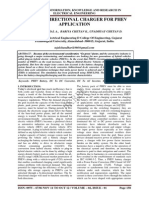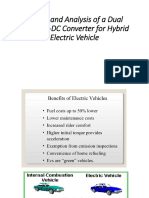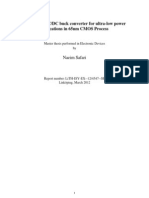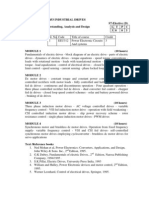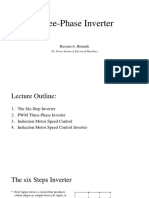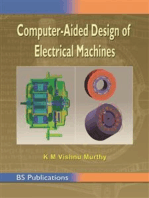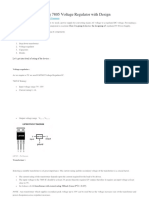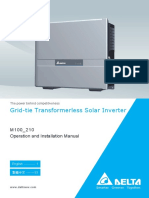0 ratings0% found this document useful (0 votes)
26 viewsModelling and Simulation of High Step Up DC To AC Converter For Microsource Application
Modelling and Simulation of High Step Up DC To AC Converter For Microsource Application
Uploaded by
theijesThe International Journal of Engineering & Science is aimed at providing a platform for researchers, engineers, scientists, or educators to publish their original research results, to exchange new ideas, to disseminate information in innovative designs, engineering experiences and technological skills. It is also the Journal's objective to promote engineering and technology education. All papers submitted to the Journal will be blind peer-reviewed. Only original articles will be published.
The papers for publication in The International Journal of Engineering& Science are selected through rigorous peer reviews to ensure originality, timeliness, relevance, and readability.
Theoretical work submitted to the Journal should be original in its motivation or modeling structure. Empirical analysis should be based on a theoretical framework and should be capable of replication. It is expected that all materials required for replication (including computer programs and data sets) should be available upon request to the authors.
Copyright:
© All Rights Reserved
Available Formats
Download as PDF, TXT or read online from Scribd
Modelling and Simulation of High Step Up DC To AC Converter For Microsource Application
Modelling and Simulation of High Step Up DC To AC Converter For Microsource Application
Uploaded by
theijes0 ratings0% found this document useful (0 votes)
26 views5 pagesThe International Journal of Engineering & Science is aimed at providing a platform for researchers, engineers, scientists, or educators to publish their original research results, to exchange new ideas, to disseminate information in innovative designs, engineering experiences and technological skills. It is also the Journal's objective to promote engineering and technology education. All papers submitted to the Journal will be blind peer-reviewed. Only original articles will be published.
The papers for publication in The International Journal of Engineering& Science are selected through rigorous peer reviews to ensure originality, timeliness, relevance, and readability.
Theoretical work submitted to the Journal should be original in its motivation or modeling structure. Empirical analysis should be based on a theoretical framework and should be capable of replication. It is expected that all materials required for replication (including computer programs and data sets) should be available upon request to the authors.
Original Title
A 03502001005
Copyright
© © All Rights Reserved
Available Formats
PDF, TXT or read online from Scribd
Share this document
Did you find this document useful?
Is this content inappropriate?
The International Journal of Engineering & Science is aimed at providing a platform for researchers, engineers, scientists, or educators to publish their original research results, to exchange new ideas, to disseminate information in innovative designs, engineering experiences and technological skills. It is also the Journal's objective to promote engineering and technology education. All papers submitted to the Journal will be blind peer-reviewed. Only original articles will be published.
The papers for publication in The International Journal of Engineering& Science are selected through rigorous peer reviews to ensure originality, timeliness, relevance, and readability.
Theoretical work submitted to the Journal should be original in its motivation or modeling structure. Empirical analysis should be based on a theoretical framework and should be capable of replication. It is expected that all materials required for replication (including computer programs and data sets) should be available upon request to the authors.
Copyright:
© All Rights Reserved
Available Formats
Download as PDF, TXT or read online from Scribd
Download as pdf or txt
0 ratings0% found this document useful (0 votes)
26 views5 pagesModelling and Simulation of High Step Up DC To AC Converter For Microsource Application
Modelling and Simulation of High Step Up DC To AC Converter For Microsource Application
Uploaded by
theijesThe International Journal of Engineering & Science is aimed at providing a platform for researchers, engineers, scientists, or educators to publish their original research results, to exchange new ideas, to disseminate information in innovative designs, engineering experiences and technological skills. It is also the Journal's objective to promote engineering and technology education. All papers submitted to the Journal will be blind peer-reviewed. Only original articles will be published.
The papers for publication in The International Journal of Engineering& Science are selected through rigorous peer reviews to ensure originality, timeliness, relevance, and readability.
Theoretical work submitted to the Journal should be original in its motivation or modeling structure. Empirical analysis should be based on a theoretical framework and should be capable of replication. It is expected that all materials required for replication (including computer programs and data sets) should be available upon request to the authors.
Copyright:
© All Rights Reserved
Available Formats
Download as PDF, TXT or read online from Scribd
Download as pdf or txt
You are on page 1of 5
The International Journal Of Engineering And Science (IJES)
|| Volume || 3 || Issue || 5 || Pages || 01-05 || 2014 ||
ISSN (e): 2319 1813 ISSN (p): 2319 1805
www.theijes.com The IJES Page 1
Modelling and Simulation of High Step up DC to AC Converter
for Microsource Application
1,
R.Sowmya,
2,
S.Rama Reddy,
1,
Research Scholar,
Sathyabhama University, Chennai, India.
2,
Professor, EEE Dept.,
Jerusalem College of Engineering, Chennai, India.
--------------------------------------------------------------ABSTRACT-------------------------------------------------------
This paper deals with modelling and simulation of high step up DC AC converter with micro source at the
input. The 15V DC is stepped up to 230V DC using high step up DC-DC Converter. This DC is converted into
AC using a single phase inverter. The DC-AC converter system is modeled and simulated using the blocks of
simulink and the results are presented in this paper.
---------------------------------------------------------------------------------------------------------------------------------------
Date of Submission: 17 February 2014 Date of Publication: 15 May 2014
---------------------------------------------------------------------------------------------------------------------------------------
I. INTRODUCTION
Renewable energy is becoming increasingly important and prevalent in distribution systems, which
provide different choices to electricity consumers whether they receive power from the main electricity source
or in forming a micro source not only to fulfill their own demand but alternatively to be a power producer
supplying a microgrid [1], [2]. A microgrid usually includes various microsources and loads, which operate as
an independent and controllable system when they are either grid-connected or islanded, as well as when they
can reliably connect or disconnect [2]. The microsource is classified either as a DC source or as a high
frequency AC source [3]. These two microsource categories are comprised of diverse renewable energy
applications, such as solar cell modules, fuel cell stacks, wind turbines, and reciprocating engines [4]. Fig.1
shows a regular schematic of a microgrid unit supplied by various microsources; the high step up converter is
used to increase the output voltage of the microsource to 380V-400 V for the dc interface to the main electricity
source through the DC-AC inverter [2],[4]. Both the single solar cell module and the fuel cell stack are
essentially low voltage sources, and thus, a high step-up voltage gain dc-dc converter is required to regulate the
voltage of the DC-DC interface.
Previous research on various converters for high step-up applications has included analyses of the
switched-inductor and switched capacitor types [5], [6], [24], [25], the boost type integrating with the switched-
capacitor technique [7],[25], the voltage-lift type [8],[9], the capacitor diode voltage multiplier type [10], and
the transformerless dc-dc converters [11],[23]. In these converters the voltage gain is not enough to convert to a
suitable ac source as a model microsource [1], in case of extremely high voltage gain is required, to using series
connection of converter is able to reach much higher voltage gain. As known, the efficiency and voltage gain of
dc-dc boost converter are restrained by either the parasitic effect of power switches or the reverse recovery issue
of diodes. In addition, the equivalent series resistance (ESR) of capacitor and the parasitic resistances of
inductor are also affecting overall efficiency [5]-[26]. Although an alternative solution is the DC-DC fly back
converter along with some advantages such as simple structure, easy control, and cost effective, the energy of
leakage inductor of the transformer leads to low efficiency and high voltage stress across the active switch. To
employ an active clamp technique not only to recycle the leakage inductor energy of the transformer but to
constrain the voltage stress is the crossed active switch [12]-[14], however, the tradeoff is of higher cost and a
complex control circuit. Some converters effectively combined both boost and fly back converters as one or
other different converter combinations are developed to carry out high step up voltage gain by using the coupled
inductor technique [15]-[17]. Due to voltage gain has restricted by the voltage stress on the active switch, once
the leakage inductor energy of the coupled inductor can be recycled that reduced the voltage stress on active
switch, this leads to the coupled inductor and the voltage multiplier or voltage-lift techniques are successfully
accomplished the goal of higher voltage gain [18]-[26].
Modelling and Simulation of High Step up DC to AC Converter for Microsource Application
www.theijes.com The IJES Page 2
This paper presents a cascaded high step-up DC-DC converter to increase the output voltage of the
microsource to a proper voltage level for the dc interface through dc-ac inverter to the main electricity grid. The
proposed converter is a quadratic boost converter with the coupled inductor in the second boost converter.
Fig.1.Basic schematic of microgrid consisted of microsources and power converters.
The circuit diagram of the high step up converter is shown in Fig 2; the proposed circuit can be divided
as a conventional boost converter and a boost-fly back converter [15]. These two segments are named first boost
stage and second boost stage. The first boost stage is like a boost converter that includes an input inductor L
in
,
two diodes D
1
and D
2
, and a pumping capacitor C
1
. The second boost stage is a boost fly back converter that
includes a dual winding coupled inductor T
1
, two diodes D
3
and D
4
, and two output capacitors C
o1
and C
o2
. In
particular, these two stages are driven by a single switch S
1
. The features of this converter are as follows:- 1) the
quadratic boost converter in effectively extended to a voltage conversion ratio and the first boost stage also
benefited the input current ripple reduction; 2) the leakage inductor energy of the coupled inductor can be
recycled, which reduces the voltage stress on the active switch, and also the conversion efficiency is
significantly improved.
II. OPERATING PRINCIPLE OF THE PROPOSED CONVERTER
The simplified circuit model of the proposed converter is shown in Fig 3. The dual-winding coupled
inductor consisted of a magnetizing inductor L
m
, primary leakage inductor L
k1
, secondary leakage inductor L
k2
,
and an ideal transformer, which constituted the primary and secondary windings, N
1
and N
2
, respectively. In
order to simplify the circuit analysis of the proposed converter, some assumptions are stated as follows.
1) All components are ideally considered except the leakage inductor of the coupled inductor. The on
State resistance R
DS(ON)
and all parasitic capacitors of the main switch S
1
are neglected; in addition,
the forward voltage drop of the diodes D
1
-D
4
is ignored.
2) All capacitors are sufficiently large, and the voltages across capacitors are considered as constant
during one switching period.
3) The ESRs of all capacitors C
1
, C
o1
, and C
o2
are neglected.
4) The turn ratio n of dual winding coupled inductor T
1
is equal to N
2
/N
1
.
Modelling and Simulation of High Step up DC to AC Converter for Microsource Application
www.theijes.com The IJES Page 3
III. SIMULATION RESULTS
The circuit of DC-AC converter system is shown in Fig 4(a). The output of solar cell is applied to the
high step up DC-DC converter. The output of the converter is applied to the inverter. The AC output of the
inverter is filtered using LC filter. The DC input voltage from the DC voltage of the solar cell is shown in Fig 4
(b). The input voltage is 15V. Measurement of power from the solar cell is shown in Fig 4 (c). The power is
obtained by multiplying voltage (V) and current (I). The gate pulses and voltage across the switch are shown in
Fig 4(d). The output voltage of the inverter with filter is shown in Fig 4(e). The current through the load is
shown in Fig 4(f). It can be seen that the current is in phase with the voltage.
Fig .4(a) Circuit diagram of DC to AC Converter
Fig.4(c) Measurement of Power
Modelling and Simulation of High Step up DC to AC Converter for Microsource Application
www.theijes.com The IJES Page 4
Fig.4 (e) Output voltage
Fig.4 (f) Output current
IV. CONCLUSION
High step up DC-AC converter with microsource at the input is successfully modelled and simulated
using MATLAB simulink. The results indicate that high step up DC-AC converter is capable of stepping up the
voltage from 15V DC to 230V AC. This high step up DC-AC converter system is a viable alternative to the
existing converters. The advantages of this converter are reduced hardware and nearly sinusoidal output voltage.
The simulation results are in line with the predictions.
This converters can be used only for low current rated loads. The scope of this work is the modelling
and simulation of high step up DC to AC converter. The hardware implementation will be done in future.
Modelling and Simulation of High Step up DC to AC Converter for Microsource Application
www.theijes.com The IJES Page 5
REFERENCES
[1] C.L.Smallwood, Distributed generation in autonomous and non autonomous micro grids, in AProc IEEE Rural Electric Power
Conf., May 2002, pp D1-1-D1-6.
[2] E.M. Fleming and I.A. Hiskens, Dynamic of a microgrid supplied by solid oxide fuel cells. in Proc. IEEE,IREP Symp., Aug
2007, pp 1-10.
[3] R.H. Lasseter, MicroGrids, IEEE, Power Eng. Soc.Winter Meet., 2002 Vol.1 pp 305-308.
[4] A.Kwasinskim and P.T. Krein, A microgrid based telecom power system using modular multiple input DC-DC converters, in
Proc. IEEE Int. Telecommun. Energy Conf. (INTELEC) 2005, pp 515-520.
[5] B. Axelrod, Y Berkovich and A.Ioinovici, Switched-capacitor/switched inductor structures for getting transformerless hybrid
DC-DC PWM converters,
[6] F.L. Luo, Switched-capacitorized DC/DC converters in Proc. IEEE c\Conf. Ind. Electron. Appl. (ICIEA), 2009. pp. 1074-1079.
[7] O. Abutbul. A. Gherlitz, Y. Berkovich, and A. Ioinovici, Step-up switching-mode converter with high voltage gain using a
switched-capacitor circuit, IEEE trans. Syst. 1, Fundam. Theory Appl., vol.50, no.8, pp 1098-1102, Aug. 2003.
[8] F.L. Luo and H. Ye, Positive output multiple-lift push-pull switched-capacitor Luo-converters, IEEE Trans. Ind. Electron., vol.
51, no.3, pp.594-602, Jun. 2004.
[9] F.L. Luo, Six self-lift DC-DC converters, voltage lift technique, IEEE Trans. Ind. Electron., vol. 48, no.6, pp.1268-1272, Dec.
2001.
[10] D.Zhou, A. Pietkiewicz, and S. Cuk, A three-switch high-voltage converter, IEEE Trans. Power Electron, vol. 14, no.1,
pp.177-183, Jan. 1999.
[11] L.S.Yang, Tamil Nadu Coop UnionJ.Liang, and J.F.Chen, Transformerless DC-DC converters with high step up voltage gain,
IEEE Trans. Ind. Electron., vol.56 no.8, pp.3144-3152, Aug, 2009.
[12] N.P.Papanikolaou and E.C. Tatakis, Active voltage clamp in flyback converters operating in CCM mode under wide load
variation, IEEE Trans. Ind. Electron, vol.51, no.3, pp.632-640, Jun, 2004.
[13] B.R.Lin and F.Y.Hsieh, Soft-switching zeta-flyback converter with a buck-boost type of active clamp, IEEE Trans. Ind.
Electron, vol.54, no.5, pp. 2813-2822, Oct, 2007
[14] F.Zhang and Y.Yan, Novel forward-flyback hybrid bidirectional DC-DC converter, IEEE Trans, Ind. Electron, vol.56, no.5,
pp.1578-1584 May 2009.
[15] K.C.Tseng and Tamil Nadu Coop UnionJ.Liang, Novel high-efficiency step-up converter, Proc. IEE Electric Power Appl.,
vol.151, no.2, pp. 182-190, Mar, 2004.
[16] Q.Zhan and F.C.Lee , High-efficiency, high step-up DC-DC converters, IEEE Trans. Power Electron., vol.18, no.1, pp. 65-73,
Jan, 2003.
[17] K.B.Park, H.W.Seong, H.S.Kim, G.W.Moon, and M.J. Youn, Integrated boost-sepic converter for high step-up applications, in
Proc. IEEE power Electron. Spec. Conf. (PESC), 2008, pp. 944-950.
[18] S.K.Changchien, Tamil Nadu Coop UnionJ.Liang, J.F.Chen, and L.S.Yang, Novel high step-up DC-DC converter for fuel cell
energy conversion system. IEEE Trans. Ind. Electron. vol.57, no.6, pp.2007-2017, Jun, 2010.
[19] R.J.Wai, C.Y.Lin, R.Y.Duan, and Y.R.Chang, High-efficiency DC-DC converter with high voltage gain and reduced switch
stress. IEEE Trans. Ind. Electron, vol.5, no.14, pp.354-364, Feb, 2007.
[20] R.J.Wai, R.Y.Duan, High step-up converter with coupled-inductor, IEEE Trans. Power Electron., vol.20, no.5, pp.1025-1035,
Sep, 2005.
[21] J.W.Back, M.H.Ryon, T.J.Kim, D.W.Yoo, and J.S.Kim, High boost converter using voltage multiplier, in Proc. 31
st
Annu.
Conf. Ind. Electron. Soc., IEEE IECON, 2005, pp. 567-572.
[22] C.S.Leu and S.Y.Wu, Anovel single-switch high conversion ratio DC-DC converter. in Proc. IEEE Power Electron. Drive
Syst. (PEDS), 2009, pp.1097-1101.
[23] B.Axelrod, Y.Berkovich, and A.Ioinovici, Transformerless DC-DC converters with a very high DC line-to-load voltage ratio.
in Proc. IEEE IScAS, 2003, vol.3, pp.435-438.
[24] B.Axelrod, Y.Berkovich, S.Tapuchi, and A.Ioinovici, Steep conversion ration Cuk. Zeta. and Sepic converters based on a
switched coupled-inductor cell. in Proc. IEEE Power Electron. Spec. Conf. (PESC), 2008, pp.3009-3014.
[25] G.Zhu and A.Ioinovici, Switched-capacitor power supplies: DC voltage ratio. efficiency. ripple, regulation. in Proc. IEEE Int.
Symp. Circuits Syst. (ISCAS), 1996, pp.553-556.
[26] R.J.Wai and R.Y.Duan, High-efficiency DC-DC converter with high voltage gain. IEEE Proc. Electr. Power Appl., vol.152,
no.4, pp.793-802.
You might also like
- SJ-20141208170916-001-ZXD3000 (V5.5) Rectifier Module User Manual PDFDocument43 pagesSJ-20141208170916-001-ZXD3000 (V5.5) Rectifier Module User Manual PDFAguilar Aguilar67% (12)
- Design of Off Board Electric Vehicle Charger Using PV Array Through Matlab-SimulinkDocument10 pagesDesign of Off Board Electric Vehicle Charger Using PV Array Through Matlab-SimulinkKrishna ReddyNo ratings yet
- Half-Bridge Bidirectional DC-DC Converter For Small Electric VehicleDocument5 pagesHalf-Bridge Bidirectional DC-DC Converter For Small Electric VehiclePradeepChandraVarmaMandapati100% (1)
- Vs Controller Gs Driver p100 Operating ManualDocument124 pagesVs Controller Gs Driver p100 Operating ManualSimon Ngigi100% (2)
- Cjv30 Maintenance v10Document101 pagesCjv30 Maintenance v10Leor Santos75% (4)
- Design Bi-Directional Charger For Phev Application: Chaudhari Tejal A., Bariya Chetan K., Upadhyay Chetan DDocument6 pagesDesign Bi-Directional Charger For Phev Application: Chaudhari Tejal A., Bariya Chetan K., Upadhyay Chetan Dmohd786azharNo ratings yet
- Design of Electrical Circuits using Engineering Software ToolsFrom EverandDesign of Electrical Circuits using Engineering Software ToolsNo ratings yet
- A High Efficiency Bi-Directional EV ChargerDocument6 pagesA High Efficiency Bi-Directional EV ChargerGabriel MejiaNo ratings yet
- Control of Bidirectional DC-DC Converter For SupercapacitorDocument8 pagesControl of Bidirectional DC-DC Converter For Supercapacitorhmaker1978No ratings yet
- Design and Analysis of A Dual Input DC-DC Converter For Hybrid Electric VehicleDocument23 pagesDesign and Analysis of A Dual Input DC-DC Converter For Hybrid Electric Vehiclejanga vishwanathNo ratings yet
- A Novel ZVS-ZCS Bi-Directional Flyback DC-DCDocument6 pagesA Novel ZVS-ZCS Bi-Directional Flyback DC-DCArceu CamposNo ratings yet
- Modeling of DC DC Converter PDFDocument6 pagesModeling of DC DC Converter PDFVishal AryaNo ratings yet
- Adaptive Fuzzy Sliding Mode Based MPPT Controller For A Photovoltaic Water Pumping SystemDocument9 pagesAdaptive Fuzzy Sliding Mode Based MPPT Controller For A Photovoltaic Water Pumping SystemIAES IJPEDSNo ratings yet
- PV BoostDocument6 pagesPV BoostlestherroqueNo ratings yet
- Buck Boost ConverterDocument3 pagesBuck Boost ConverterArnoldo ZereceroNo ratings yet
- A Novel Single Phase Cascaded H-Bridge Inverter With Reduced Power Electronics SwitchesDocument8 pagesA Novel Single Phase Cascaded H-Bridge Inverter With Reduced Power Electronics SwitchesHemanth KumarNo ratings yet
- DC-DC Converter Fault (Important Paper)Document16 pagesDC-DC Converter Fault (Important Paper)shan.rahmanNo ratings yet
- PPTDocument32 pagesPPTsingh vipulNo ratings yet
- Low Power Boost Converter For Portable Applications by Eddy Wells and Mark JordanDocument9 pagesLow Power Boost Converter For Portable Applications by Eddy Wells and Mark JordanberbouNo ratings yet
- Study and Design, Simulation of PWM Based Buck Converter For Low Power ApplicationDocument17 pagesStudy and Design, Simulation of PWM Based Buck Converter For Low Power ApplicationIOSRjournalNo ratings yet
- Multi LVL DC DC BoostDocument9 pagesMulti LVL DC DC BoostDurga PrathibhaNo ratings yet
- Cuk, Sepic Zeta NptelDocument20 pagesCuk, Sepic Zeta NptelAvinash Babu KmNo ratings yet
- Multilevel Inverter CascadedDocument20 pagesMultilevel Inverter Cascadedpepikli100% (1)
- Four Quadrant OperationDocument9 pagesFour Quadrant OperationMOTILAL SUTHAR215291No ratings yet
- Multilevel InverterDocument92 pagesMultilevel Invertermohitsingh421421No ratings yet
- Design of LCL Filters For The Back-To-Back Converter in A Doubly Fed Induction Generator PDFDocument7 pagesDesign of LCL Filters For The Back-To-Back Converter in A Doubly Fed Induction Generator PDFStefania OliveiraNo ratings yet
- Slup 129Document11 pagesSlup 129Sameer NandanNo ratings yet
- A G2V V2G Off Board Fast Charger For Charging of Lithium Ion Based Electric VehiclesDocument6 pagesA G2V V2G Off Board Fast Charger For Charging of Lithium Ion Based Electric Vehiclesmahesh giteNo ratings yet
- TIDUE531 10-kW, Bidirectional Three-Phase Three-Level (T-Type) Inverter and PFCDocument94 pagesTIDUE531 10-kW, Bidirectional Three-Phase Three-Level (T-Type) Inverter and PFCvituvxiaomi redmi5plusNo ratings yet
- Vemu HVDC NotesDocument125 pagesVemu HVDC NotesDEPARTMENT OF EEE SVEWNo ratings yet
- Ee2352 Solid State Drives PDFDocument1 pageEe2352 Solid State Drives PDFMuruga Raj0% (1)
- 17ee82 - Ida - Mod 4 NotesDocument18 pages17ee82 - Ida - Mod 4 NotesManish Kumar SahaniNo ratings yet
- DC Motor Speed ControllerDocument22 pagesDC Motor Speed ControllerShafqt MbrkNo ratings yet
- Eee 304 Lecture Notes - 1Document171 pagesEee 304 Lecture Notes - 1Haritha RkNo ratings yet
- PPTDocument25 pagesPPTSaranya GuttulaNo ratings yet
- Chapter 3: Electric Drives and Converters Feeding Electric MotorsDocument11 pagesChapter 3: Electric Drives and Converters Feeding Electric MotorsSelemon AssefaNo ratings yet
- Last PDF of Project ReportDocument18 pagesLast PDF of Project ReportRAVINA MANGAL100% (1)
- Speed Control of BLDC MotorDocument20 pagesSpeed Control of BLDC MotorPraveen GsNo ratings yet
- Lecture - 4 - Modeling of DC MachinesDocument23 pagesLecture - 4 - Modeling of DC Machinesstubborn002No ratings yet
- Ssemd PPT1Document205 pagesSsemd PPT1control 4uonlyNo ratings yet
- Assignment 1Document11 pagesAssignment 1Nhất Vy ĐặngNo ratings yet
- Boost ConverterDocument8 pagesBoost Converterhamza abdo mohamoudNo ratings yet
- Self Switch Power SupplyDocument1 pageSelf Switch Power Supplymontes24No ratings yet
- DC - Ac Inv.Document82 pagesDC - Ac Inv.Jegadeeswari GNo ratings yet
- Buck ConverterDocument73 pagesBuck Convertermounicapaluru_351524No ratings yet
- 351 - 27435 - EE419 - 2016 - 1 - 2 - 1 - 0 3 EE419 Lec6,7 Compensation RLDocument47 pages351 - 27435 - EE419 - 2016 - 1 - 2 - 1 - 0 3 EE419 Lec6,7 Compensation RLtsegayNo ratings yet
- Multi Level InverterDocument4 pagesMulti Level InverterabsalnabiNo ratings yet
- CONVERTERSDocument32 pagesCONVERTERSMichael CampbellNo ratings yet
- Wireless DC Motor Speed and Direction Control Using RFDocument3 pagesWireless DC Motor Speed and Direction Control Using RFNidhin MnNo ratings yet
- Industrial DrivesDocument1 pageIndustrial DrivesSatish NurukurthiNo ratings yet
- UPFCDocument10 pagesUPFCAJAN ANo ratings yet
- 1DC Motor - Separated and ShuntDocument22 pages1DC Motor - Separated and ShuntKasiye KebedeNo ratings yet
- Three Phase InverterDocument18 pagesThree Phase InverterAbdulrahman AhmedNo ratings yet
- Q1. What Do You Mean by Harmonics?Document3 pagesQ1. What Do You Mean by Harmonics?vinesh_viswanathan_3100% (1)
- Dual ConvertersDocument13 pagesDual ConvertersGabriel SanthoshkumarNo ratings yet
- Variable Frequency Drive Navigation Search: From Wikipedia, The Free EncyclopediaDocument9 pagesVariable Frequency Drive Navigation Search: From Wikipedia, The Free EncyclopediaMadhar ShaNo ratings yet
- Unit Iii Induction Motor Drives: Dept. of EEEDocument17 pagesUnit Iii Induction Motor Drives: Dept. of EEEmanoj kumarNo ratings yet
- Electric Vehicle 4th ModuleDocument13 pagesElectric Vehicle 4th ModuleAmruth DeshpandeNo ratings yet
- SEPIC ConverterDocument6 pagesSEPIC ConverterĢÜŘŲ Ŕäņđhäwä0% (1)
- Buck ConvertersDocument15 pagesBuck Convertersmuddassir07100% (2)
- Defluoridation of Ground Water Using Corn Cobs PowderDocument4 pagesDefluoridation of Ground Water Using Corn Cobs PowdertheijesNo ratings yet
- Mixed Model Analysis For OverdispersionDocument9 pagesMixed Model Analysis For OverdispersiontheijesNo ratings yet
- Design and Simulation of A Compact All-Optical Differentiator Based On Silicon Microring ResonatorDocument5 pagesDesign and Simulation of A Compact All-Optical Differentiator Based On Silicon Microring ResonatortheijesNo ratings yet
- Influence of Air-Fuel Mixtures and Gasoline - Cadoba Farinosa Forskk Bioethanol Fuel Mixtures On Emissions of A Spark - Ignition Engine.Document9 pagesInfluence of Air-Fuel Mixtures and Gasoline - Cadoba Farinosa Forskk Bioethanol Fuel Mixtures On Emissions of A Spark - Ignition Engine.theijesNo ratings yet
- Chapter 1c (RECTIFIER)Document15 pagesChapter 1c (RECTIFIER)Akmal Amyrul Aizat100% (1)
- Astm F496Document8 pagesAstm F496Aditya Man100% (1)
- RF Controlled Solar Panel Based Robotic VehicleDocument6 pagesRF Controlled Solar Panel Based Robotic VehicleMohan Babu ANo ratings yet
- 07a70201 PowersemiconductordrivesDocument6 pages07a70201 PowersemiconductordrivesSamiullah MohammedNo ratings yet
- Is 16101 2012Document17 pagesIs 16101 2012gayathrikanduriNo ratings yet
- Advr 12 ManualDocument10 pagesAdvr 12 ManualLuciano PereiraNo ratings yet
- Mathematical Modeling of Melting Rates For Submerged Arc WeldingDocument6 pagesMathematical Modeling of Melting Rates For Submerged Arc WeldingARUN VNo ratings yet
- Rectifier: Characteristics of A Rectifier CircuitDocument4 pagesRectifier: Characteristics of A Rectifier CircuitDinesh VelNo ratings yet
- Service Manual - Heraeus - Cryofuge 6000i, 8500iDocument145 pagesService Manual - Heraeus - Cryofuge 6000i, 8500iHishamudin RaisNo ratings yet
- Daewoo+Koc 621Document36 pagesDaewoo+Koc 621Paulo HoffmannNo ratings yet
- Fin Irjmets1656767382Document7 pagesFin Irjmets1656767382ukavnganesh2002No ratings yet
- Guide For RDS-PSDocument9 pagesGuide For RDS-PSyoonghmNo ratings yet
- Power Adpater (2PIN)Document72 pagesPower Adpater (2PIN)Ismael Boada0% (1)
- Three-Phase Overcurrent Relay Spaj 131 C: Product GuideDocument12 pagesThree-Phase Overcurrent Relay Spaj 131 C: Product GuideSharaf Ali ZyoudNo ratings yet
- Netsure 7100 Data Sheet With Esure Power Extend ConvertersDocument2 pagesNetsure 7100 Data Sheet With Esure Power Extend ConvertersCedillo Cortés SaraNo ratings yet
- 6/14/02 Chapter 14: Use of Electrical Test Equipment 1/20Document20 pages6/14/02 Chapter 14: Use of Electrical Test Equipment 1/20LeonardNo ratings yet
- M.Tech IIT Bhubaneswar - Syllabus of Electrical Power SystemsDocument24 pagesM.Tech IIT Bhubaneswar - Syllabus of Electrical Power SystemsPiyush ShrivastavaNo ratings yet
- CMCP 575Document3 pagesCMCP 575Venkat Subramanyam.CNo ratings yet
- KD100 Manual Mas Nuevo 2023Document200 pagesKD100 Manual Mas Nuevo 2023proyectosvendomNo ratings yet
- DSE9470 MKII Data SheetDocument2 pagesDSE9470 MKII Data SheetArnelNo ratings yet
- Static Exciter RegulatorDocument24 pagesStatic Exciter RegulatorMauricio GuanellaNo ratings yet
- 5V Power Supply Using 7805 Voltage Regulator With DesignDocument25 pages5V Power Supply Using 7805 Voltage Regulator With DesignLawrence Ngari100% (2)
- Chapter-1 1.1 Introduction To The Project: Vehicle Theft Detection and Tracking Notification With Remote Engine LockingDocument45 pagesChapter-1 1.1 Introduction To The Project: Vehicle Theft Detection and Tracking Notification With Remote Engine LockingJayanthTippireddy100% (1)
- Density Based Traffic Control Using Arduino & Ir SensorsDocument39 pagesDensity Based Traffic Control Using Arduino & Ir Sensorshamed razaNo ratings yet
- M100 - 210 ManualDocument166 pagesM100 - 210 ManualABCDNo ratings yet
- Operation Manual HSI500 HSI640 HS1000 HSI1250 V31 EngDocument76 pagesOperation Manual HSI500 HSI640 HS1000 HSI1250 V31 Enguniver2011No ratings yet






